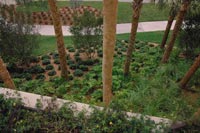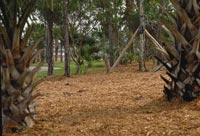Home >>> Landscaping >> Xeriscaping
Xeriscaping
 What
is xeriscaping?
What
is xeriscaping?
“Xeri” is derived from the Greek “xeros,” meaning dry and “scape” is a kind of view or scene. Together, xeriscaping is landscaping with slow-growing, drought-tolerant plants to conserve water and establish a waste-efficient landscape.
Landscapes can be designed from the start to reduce the amount of resources needed to maintain it. By selecting the appropriate plants and efficient irrigation systems, a balance can be achieved to fit your aesthetic needs as well as reduce resource use. Benefits of xeriscaping include cost savings through lower water bills and a reduction in labor needed to maintain your landscape.
The elements of xeriscaping
Designing a resource-efficient landscape requires the incorporation of a few design elements:
Zoning—grouping plants in the landscape according to their water requirements. For example, water-loving plants should be grouped separately from drought-tolerant plants. This allows for the proper amount of water to be distributed to the plants as they need it.
Use of drought-tolerant plants—these plants require less water and are adapted to drought conditions and soils with low water-holding capacities.
 Drought-tolerant
turf—bahiagrass, bermudagrass, and zoysiagrass all have
excellent drought tolerance. Allow the turf to go dormant during dry
periods. When the rain comes, these grasses will turn green again.
Drought-tolerant
turf—bahiagrass, bermudagrass, and zoysiagrass all have
excellent drought tolerance. Allow the turf to go dormant during dry
periods. When the rain comes, these grasses will turn green again.
Mulch, mulch, mulch—because mulch reduces evaporation, it is used extensively in xeriscaping to replace areas that require extensive watering. Mulch can also be used to create paths or walkways throughout your landscape.

